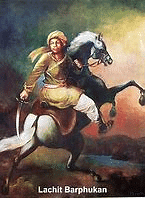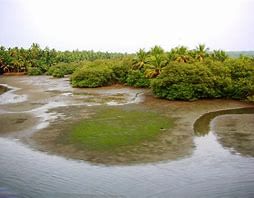UPSC Daily Current Affairs- 20th November 2023 | Current Affairs & Hindu Analysis: Daily, Weekly & Monthly PDF Download
GS-I
Lachit Borphukan
Subject: Art and Culture

Why in News?
An animation film on an iconic Ahom general Lachit Borphukan has been selected for the International Film Festival of India (IFFI) 2023 to be held in Goa.
Lachit Borphukan
- Lachit Borphukan was a legendary military commander from the northeastern region of India, specifically from the state of Assam. Here are some facts related to him:
| Description | |
| Timeline | 1622-1672 |
| Dynasty | Ahom Dynasty |
| Mughal Threat | Faced the Mughal Empire’s expansion into Assam |
| Battle of Saraighat | Led Ahom forces to victory against the Mughals in 1671 Defended Assam against the Aurangzeb’s forces led by Ram Singh |
| Leadership | Known for strategic brilliance and guerrilla tactics |
| Legacy | Revered as a symbol of Assamese pride and resistance |
| INS Lachit | Indian Navy’s guided-missile destroyer named in honor |
| Lachit Divas | Celebrated annually on November 24th in Assam |
Source: The Hindu
GS-II
The debate over appropriate age of admission to Class 1
Subject: Polity and Governance

Why in News?
Schools in Delhi this year will continue to admit students to Class 1 below the age of 6 years.
- This is contrary to recent letters from the Union government to all states, urging them to align the age of entry to Class 1 with the new National Education Policy 2020.
- According to a response furnished by the Union government in the Lok Sabha, there are wide variations in the age criteria among states when it comes to admission to Class 1.
- There were 14 States and Union Territories, as of March 2022, that allow Class 1 admission for children who have not completed six years.
What does the NEP 2020 say about the minimum age to admit students in Class 1?
- The new NEP pitches for a “5+3+3+4” design for formal schooling corresponding to:
- the age groups 3-8 years (foundational stage),
- 8-11 years (preparatory stage),
- 11-14 years (middle stage), and
- 14-18 years (secondary stage).
- This brings early childhood education (also known as pre-school education for children of ages 3 to 5 years) under the ambit of formal schooling.
- This effectively means that a child should be 6 years old to be eligible for admission into Class 1, after completing three years of early childhood education.
What does the Right to Education (RTE) Act, 2009 say about the age of entry for Class 1?
- The RTE Act guarantees education from the age of 6 years to 14 years.
- This means that a child is expected to begin elementary education (i.e., Class 1) at the age of 6 years.
- RTE Act had to specify the entry age for enforcement of formal compulsory education.
- This has been ignored even now by many States leading to the confusion of the actual age for admitting students grade1.
Opinions of academicians on this issue
- As per the academicians in India:
- The age of 6 years was identified considering the universal age that most countries across the world have been following, i.e., to admit a child into grade one at the age of 6 or 7.
- The age 6, which the RTE says is the age to begin Class 1, is simply a reiteration of what has already been a part of our Constitution.
- This was also the same in Gandhi’s idea of basic education.
- It was also stated in the report of the Sargent Commission (on post-war education development in India), which goes back to the 1940s.
What does research say about the entry age for formal education?
- As per the research conducted by David Whitebread, from the Faculty of Education at Cambridge University:
- the early introduction of formal learning approaches to literacy does not improve children’s reading development, and may be damaging.
- By the age of 11, there was no difference in reading ability level between the two groups.
- But the children who started at 5 developed less positive attitudes to reading and showed poorer text comprehension than those children who had started later.
- In a separate study of reading achievement in 15-year-olds across 55 countries, researchers showed that there was no significant association between reading achievement and school entry age.
What is the age to start formal education across the world in various countries?
- Six is the standard age for starting primary school across East Asia, not just in Japan.
- This age is also common in most European countries.
- It is usual (though not compulsory) for younger children in these societies to attend some sort of preschool.
- However, in the USA and the UK children generally start school at 5.
Source: Indian Express
India’s Global Talent Competitiveness Ranking falls to 103
Subject: Governance

Why in News?
India’s ranking in the Global Talent Competitiveness Index (GTCI) has significantly declined from 83 a decade ago to 103 in the latest report released this month.
- India now finds itself positioned between Algeria (ranked 102) and Guatemala (ranked 104), all classified as lower-middle-income countries.
About Global Talent Competitiveness Index (GTCI)
- The GTCI ranks 134 countries based on their ability to grow, attract, and retain talent.
- It is released by INSEAD, a partner and sponsor of the United Nation’s Sustainable Development Goals (SDGs)Davos, Switzerland recently.
- INSEAD is one of the world’s leading and largest graduate business schools with locations all over the world and alliances with top institutions.
- The report ranks countries based on 6 pillars:
- enable
- attract
- grow
- retain talent
- vocation and technical skills
- global knowledge skills
India’s Ranking and Comparisons
- Rank 103: India’s current rank is well below the median score of the countries assessed in the GTCI.
- BRICS Nations: India’s performance in the GTCI is the weakest among the BRICS countries. China leads the group at rank 40, followed by Russia at 52, South Africa at 68, and Brazil at 69.
- Top Three Countries: These are Singapore, Switzerland, and the United States.
- Skills Mismatch: India faces an increased skills mismatch and difficulties in finding skilled employees, resulting in its low rankings in the ‘Employability’ and ‘Vocational and Technical Skills’ categories.
- Best-Performing Area: India’s best-performing area in the GTCI is “Global Knowledge Skills,” driven by innovation and software development, contributing to its 69th position in the “Talent Impact” sub-pillar.
Source: The Hindu
Governor’s right to withhold assent
Subject: Governance

Why in News?
Tamil Nadu’s Governor R N Ravi’s decision to withhold assent to 10 pending Bills has raised fresh legal questions on the powers of the Governor.
- This comes at a time when at least four opposition-ruled states including Tamil Nadu are before the Supreme Court seeking its intervention on defining the contours of the Governor’s powers in the lawmaking process.
What does the Constitution say about the Governor’s role in giving assent to Bills?
- Although, Article 163 of the Constitution deals with the powers of the Governor generally, Article 200 specifically deals with the issue of granting assent to Bills.
- Both the provisions are read together to determine the contours of the power the Governor holds on this issue.
- When a Bill passed by the legislature of a state is presented to the Governor, the Governor has four options:
- grant assent to the Bill;
- withhold assent to the Bills;
- return the Bills for reconsideration; or
- reserve the Bill for the consideration of the President.
- Article 200 states that:
- When a State Legislative Assembly passes a bill, or in a State with a Legislative Council, when both houses of the legislature pass the bill, the bill is then presented to the Governor.
- The Governor has three options: to approve the bill (assent), reject the bill (withhold assent), or hold off on a decision and refer the bill to the President for consideration.
- However, the Article has a key proviso. It says that the Governor “may, as soon as possible” return Bills other than money Bills, with a message requesting that the House reconsider it in parts or in whole.
- However, once the Legislative House reconsiders the Bill and sends it to the Governor once again, the Governor “shall not withhold assent therefrom”.
Bone of contention
- The tug-of-war between the government and the Governor in the Opposition-ruled states essentially lies in the wordplay in the proviso.
- The proviso says the Governor must return the Bill “as soon as possible” but does not prescribe a specific timeframe.
- Raj Bhavans have exploited this ambiguity to sit on Bills indefinitely without returning them to the state legislature.
Can a Governor in practice actually sit on a Bill forever?
- An indefinite timeline in deciding on Bills can in effect amount to paralysing the elected government.
- At the same time, giving assent to Bills is one of the few areas in which the Governor can exercise his discretion.
- But this discretion cannot be used arbitrarily or based on a personal preference, but only in Constitutional terms with cogent reasons.
- Additionally, Article 200 uses the word “shall” which indicates that the framers of the Constitution intended a mandatory tone for the Governor on this aspect.
What is the viewpoint of SC on this?
- The SC in its landmark 2016 ruling in the Arunachal Pradesh Assembly case (Nabam Rebia and Bamang Felix vs Deputy Speaker) discussed this aspect briefly.
- It said that the Governor cannot withhold assent to a Bill indefinitely but must return it to the Assembly with a message and this could include his recommendation for amendments to the Bill.
What can the Supreme Court do now?
- Tamil Nadu, Kerala, Telangana, and Punjab, have sought the intervention of the Supreme Court on the issue.
- Several aspects dealing with the Governor’s powers have been litigated extensively, and there is now settled law on these aspects.
- This includes the role in recommending President’s Rule, inviting the party with a majority to form the government, or during a trust vote.
- The SC has now been called upon to decide a new aspect — whether it can fix a timeline for Governors to give assent to Bills, which amounts to deciding whether it can prescribe limits to an office exercising constitutional powers.
- In the past, the court has reluctantly fixed timelines for the Speaker’s office to decide disqualification cases.
- A Governor cannot be made a party before the Supreme Court.
- Generally, therefore, the court issues notice to the Secretary of the Governor in such disputes.
Source: The Hindu
GS-III
GI tag for Sea Buckthorn
Subject: Economics

Why in News?
The Geographical Indication Registry has officially granted the GI tag to ‘Ladakh Sea Buckthorn’.
- It is the fourth GI tag after Apricot (Raktsey Karpo), Pashmina, and Ladakhi Wood Carving in Ladakh.
About Sea Buckthorn
- Sea buckthorn is a plant that grows in Europe and Asia.
- In India, it’s found in the Himalayan region, especially in dry places like the cold deserts of Ladakh and Spiti.
- This plant produces small orange or yellow berries that are sour but full of vitamins, especially vitamin C.
- It can survive really hot and really cold temperatures, which makes it perfect for the cold deserts.
- Every part of the plant—berries, leaves, twigs, roots, and thorns—are useful for medicine, food, fuel, and fencing.
- It’s also a vital food source for many birds and provides nutritious food for animals like sheep, goats, donkeys, cattle, and camels in the cold desert regions.
- It is often called the ‘Wonder Plant,’ ‘Ladakh Gold,’ ‘Golden Bush,’ or ‘Gold Mine’ of the cold deserts.
About GI Tag
- A GI is a sign used on products that have a specific geographical origin and possess qualities or a reputation that are due to that origin.
- Nodal Agency: Department for Promotion of Industry and Internal Trade (DPIIT), Ministry of Commerce and Industry
- India, as a member of the World Trade Organization (WTO), enacted the Geographical Indications of Goods (Registration and Protection) Act, 1999 w.e.f. September 2003.
- GIs have been defined under Article 22 (1) of the WTO Agreement on Trade-Related Aspects of Intellectual Property Rights (TRIPS) Agreement.
- The tag stands valid for 10 years.
Source: DTE
Kadalundi Mudflats
Subject: Environment and Ecology

Why in News?
Kadalundi’s mudflats are shrinking drastically with sands cover.
- These mudflats have been a vital source of sustenance for thousands of migrant shorebirds, offering abundant prey like polychaetes and crustaceans.
About Kadalundi Mudflats
- Kadalundi Mudflats are situated in the Kadalundi Bird Sanctuary, which is located in the Kozhikode district of Kerala, along the southwestern coast of India. The sanctuary encompasses estuarine wetlands, mudflats, and mangrove forests.
- The mudflats are part of the estuarine ecosystem formed at the confluence of the Kadalundi River and the Arabian Sea.
- This unique environment is influenced by both freshwater from the river and saline water from the sea, creating a diverse habitat.
Ecological significance
- Kadalundi Mudflats are renowned for their rich biodiversity, especially in terms of avian species.
- The Kadalundi Bird Sanctuary and the mudflats are protected under the Wildlife Protection Act of 1972.
- The mudflats serve as a critical habitat for various resident and migratory birds.
- It is estimated that over 100 species of resident and migratory birds visit the area, making it a paradise for birdwatchers and ornithologists.
- They are a crucial stopover point for migratory birds travelling along the East Asia-Australasia Flyway.
Source: The Hindu
Cosmic Vine
Subject: Science and Technology

Why in News?
A team of researchers recently identified an extensive galaxy structure named "Cosmic Vine”.
About Cosmic Vine:
- It is a massive “vine-like structure” that encompasses 20 galaxies and stretches for over 13 light years.
- It’s also very ancient. The researchers pegged it at redshift 3.44, meaning it’s situated in the early universe. (Redshift refers to the way light stretches as it travels longer distances through time, with higher redshifts indicating an object is older).
- A redshift of 3.44would mean light from the Cosmic Vine has been traveling for between 11 and 12 billion years before reaching JWST. To provide context, current methods estimate the universe's age at 13.7 billion years.
- It harbours two of the most massive galaxies ever discovered at such a high redshift—Galaxy A and Galaxy E, both in a quiescent state, indicating a reduced rate of star formation.
- Researchers believe that the Vine might serve as the precursor to a galaxy cluster, providing insights into the formation of such clusters and the emergence of massive galaxies within them.
What is a Light Year?
- A light-year is a measurement of distance and not time (as the name might imply).
- It is the distance a beam of light travels in a single Earth year, which equates to approximately 6 trillion miles (9.7 trillion kilometres).
- It is used to measure the vast distances of space.
Source: The Hindu
|
38 videos|5283 docs|1116 tests
|
FAQs on UPSC Daily Current Affairs- 20th November 2023 - Current Affairs & Hindu Analysis: Daily, Weekly & Monthly
| 1. What is the appropriate age for admission to Class 1 in India? |  |
| 2. What is India's Global Talent Competitiveness Ranking? |  |
| 3. Can a Governor withhold their assent? |  |
| 4. What is the GI tag for Sea Buckthorn? |  |
| 5. What are Kadalundi Mudflats? |  |
















